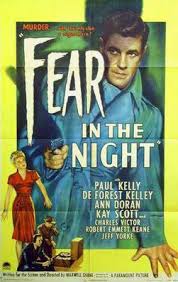
“I’ve got an honest man’s conscience in a murderer’s body.”
Vince Grayson (DeForest Kelley) is having a nightmare. In it he is in a mirrored room. There are a man and a woman in the room. They see him. The man struggles with him trying to choke him. Vince pulls a button off the man’s jacket. The woman tries to hand the man a weapon. A metal paper spike. Vince ends up with it and stabs the man. The woman runs out of the room. In a panic Vince stuffs the dead man in a closet. He locks the door and takes the key. The door slowly opens. Vince is desperately looking for a way out of the mirrored room. He opens a door and steps through. Suddenly he is falling, falling. He wakes up in his hotel room, in bed, covered in sweat.
Realizing he was dreaming Vince gets up and gets ready for work. In the bathroom he sees marks on his throat. They weren’t there the night before. Then he finds a splotch of blood on his hand. In his pocket are a key and a button. They aren’t his. Vince is beginning to realize that what happened was not a dream, it was real. But how? Now he feels sick. He calls his boss at the bank to tell him he wouldn’t be in that day.
Vince goes to see his brother-in-law Cliff Herlihy (Paul Kelly) and explains the situation to him. Cliff is a policeman. Cliff tells him he was dreaming but Vince is upset that his brother-in-law won’t believe him. Convinced there is some truth to his dream Vince tries to find the house. He puts an ad in the paper looking to rent a house with an octagon shaped mirrored room. Frustration builds when nothing comes of it. Vince begins to withdraw from life.
A few days later Vince and his wife Lil (Ann Doran) take a protesting Vince and his girlfriend Betty Winters (Kay Scott) out in the country for a picnic. When it starts to rain they head back to town. On the way back Cliff realizes his wind shield wipers aren’t working. Vince subconsciously directs them to a large house. The house is empty but they find a key in a planter.
Inside Vince begins to wander around the house. Upstairs he opens a door. In front of him is another door. When he opens it up he’s in the mirrored room. Cliff enters the room and sees the mirrors. Taking the key from Vince he unlocks a closet door. There’s no body inside but there is dried blood on the wall. Cliff now believes that Vince killed someone but he believes he did it in cold blood.
“Fear In the Night” was released in 1947 and was directed by Maxwell Shane. It is an American crime drama and a film noir. The film is based on the story “And so to Death” by Cornell Woolrich using one of his pen names, William Irish. It is one of Paramount’s low budget “B” movies. The film was remade in 1956 as “Nightmare”. It features a very young DeForest Kelley in his first full length film and he does a good job.
The film itself is good. The suspense and mystery stays with it, unfolding leisurely. There are plot issues yes, but it’s still a nice noir story that keeps you interested. It’s not Hitchcock sure, but it has some of the plot twists and a dark surreal atmosphere that Hitch would approve of. Author Cornell Woolrich wrote many stories that Hitchcock adapted to the screen. “Rear Window” 1954 for example and several stories for Hitchcock’s television series. Many of Woolrich's stories were adapted for television and movies.
References have been made to it having a homosexual subtext. I may have to disagree on that point. That may be projection based on the author’s life and not the film itself. Cornell Woolrich may have been an excellent crime writer but he was a self hating gay man that took his demons out on everyone else. Reportedly he married a young woman and refused to sleep with her. Instead he gave her written accounts of his sexual encounters with other men. Living a good part of his life with an overbearing mother added to his mental maliciousness. As a result he became an alcoholic and a diabetic. An unattended foot infection became gangrene resulting in the amputation of a leg.
Woolrich’s style of writing was nightmarish. Plot came second to image and emotion. Some believe he wrote the way his life was. Perhaps “Fear in the Night” is just what he dreamt of the night before. Nightmares aren’t supposed to make sense; they’re just supposed to scare you.

